Nakgyoon Choi, Kyu Yub Lee and Hyuk-Hwang Kim: International Comparison and Trade Effects of Digital Innovation
2019-02-19 IMI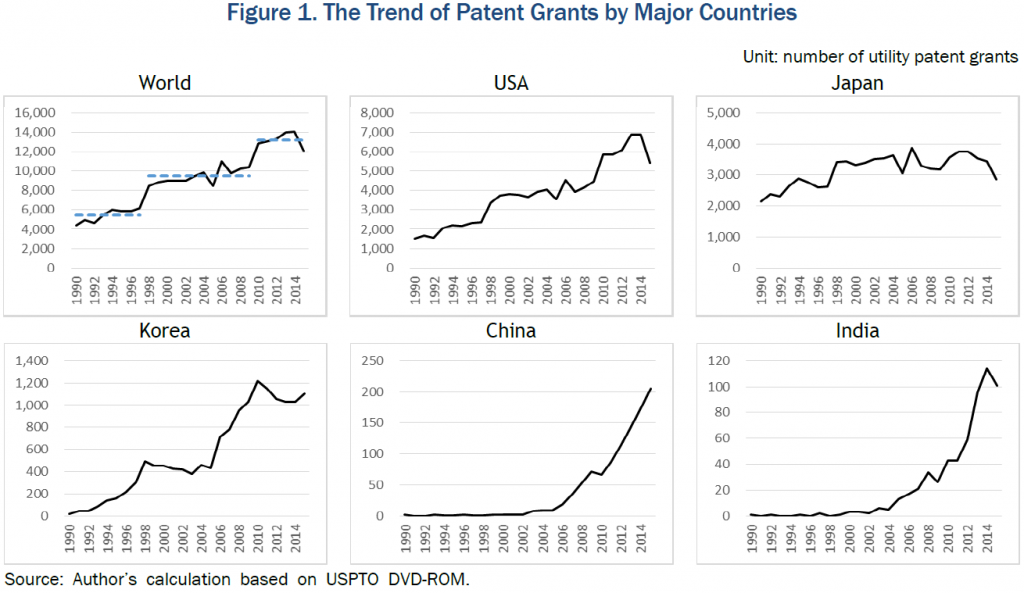
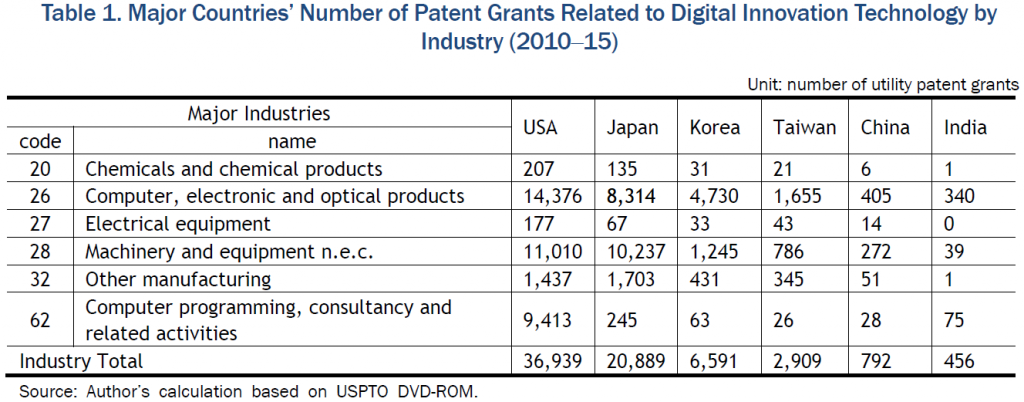
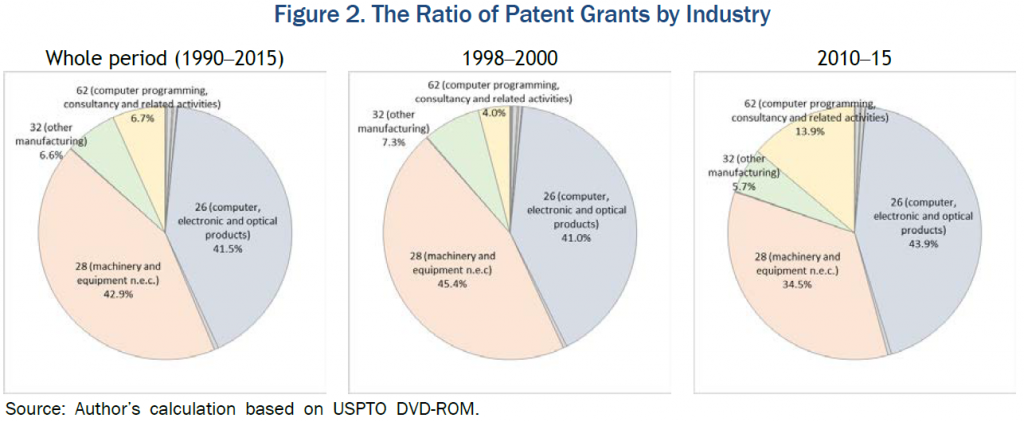 Many of the robots that were installed and in operation during 2011‒16 are used in the manufacturing of automotives, electrical and electronics, metal, plastics and chemical products. Korea uses a large number of robots in the electrical and electronics sectors, unlike other major countries that use many robots in the automotive sector.
Lastly, as for the other indicators of digital utilization, the usage of ICT at enterprises is not very high in Korea, with the exception of RFID utilization, despite the very high usage rate of high-speed internet at enterprises (99.3%) and households (99.5%).
IV. The Impact of Digital Innovation on International Trade
This chapter examines the impact of digital innovation on international trade. Digital innovation denotes new products and processes based on data and software codes. Since it is widely known that there is a positive correlation between innovation and productivity, it is natural to conjecture that digital innovation would have an impact on international trade due to changes in fundamental productivity. We select a structural approach rather than a reduced-form econometric approach due mainly to the paucity of relevant data.
A. The Model
Many of the robots that were installed and in operation during 2011‒16 are used in the manufacturing of automotives, electrical and electronics, metal, plastics and chemical products. Korea uses a large number of robots in the electrical and electronics sectors, unlike other major countries that use many robots in the automotive sector.
Lastly, as for the other indicators of digital utilization, the usage of ICT at enterprises is not very high in Korea, with the exception of RFID utilization, despite the very high usage rate of high-speed internet at enterprises (99.3%) and households (99.5%).
IV. The Impact of Digital Innovation on International Trade
This chapter examines the impact of digital innovation on international trade. Digital innovation denotes new products and processes based on data and software codes. Since it is widely known that there is a positive correlation between innovation and productivity, it is natural to conjecture that digital innovation would have an impact on international trade due to changes in fundamental productivity. We select a structural approach rather than a reduced-form econometric approach due mainly to the paucity of relevant data.
A. The Model
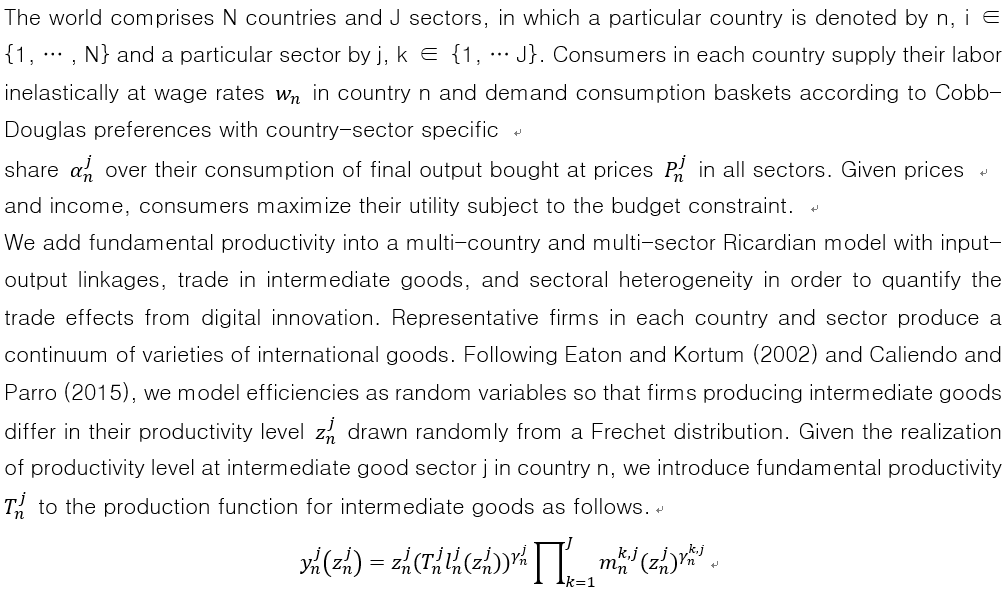
 On equilibrium under trade costs and exogenous variables, a wage vector and prices satisfy equilibrium conditions, including a number of optimal behavior of consumers and producers and market clearing conditions in each country.
B. Changes in equilibrium and data
We highlight the link between digital innovation and productivity and between productivity and international trade on a general equilibrium setting to answer counterfactual questions. In order to perform the counterfactual analysis, we first calculate changes in equilibrium following the popular hat calculus.
Cost bundles (N × J equations)
On equilibrium under trade costs and exogenous variables, a wage vector and prices satisfy equilibrium conditions, including a number of optimal behavior of consumers and producers and market clearing conditions in each country.
B. Changes in equilibrium and data
We highlight the link between digital innovation and productivity and between productivity and international trade on a general equilibrium setting to answer counterfactual questions. In order to perform the counterfactual analysis, we first calculate changes in equilibrium following the popular hat calculus.
Cost bundles (N × J equations)
 where it is assumed that the world trade is balanced.
Given a system of equations as above, we next measure digital innovation by extracting patents data pertinent to new technology such as Artificial Intelligence, Big Data, Machine Learning, Cloud Computing, and others recorded in the United States Patent and Trade-mark Organization from 2011 to 2015 (Figure 3).
Next, we proceed to concord the extracted patents data to International Standard Industrial Classification Revision 4. Then, we use the constructed patents data (Figure 3) to generate changes in fundamental productivity at sector-level to examine the trade impact of digital innovation. In addition, we consider changes in fundamental productivity at country-level of estimates from previous studies (e.g., Craft 2004; Craetz and Michaels 2015; O’Mahony and Timmer 2009; McKinsey Global Institute 2017).
In all cases, we use data from the World Input-Output Table released in 2016 to calculate exogenous variables such as input-output coefficients, value-added share, and share of consumption expenditures for the model.
where it is assumed that the world trade is balanced.
Given a system of equations as above, we next measure digital innovation by extracting patents data pertinent to new technology such as Artificial Intelligence, Big Data, Machine Learning, Cloud Computing, and others recorded in the United States Patent and Trade-mark Organization from 2011 to 2015 (Figure 3).
Next, we proceed to concord the extracted patents data to International Standard Industrial Classification Revision 4. Then, we use the constructed patents data (Figure 3) to generate changes in fundamental productivity at sector-level to examine the trade impact of digital innovation. In addition, we consider changes in fundamental productivity at country-level of estimates from previous studies (e.g., Craft 2004; Craetz and Michaels 2015; O’Mahony and Timmer 2009; McKinsey Global Institute 2017).
In all cases, we use data from the World Input-Output Table released in 2016 to calculate exogenous variables such as input-output coefficients, value-added share, and share of consumption expenditures for the model.
 C. Counterfactual Results
We consider ten different scenarios depending on productivity shocks (changes in Tn) from sector-level and country-level. However, we can only show part of the main results in Table 2 due to space limitation.
C. Counterfactual Results
We consider ten different scenarios depending on productivity shocks (changes in Tn) from sector-level and country-level. However, we can only show part of the main results in Table 2 due to space limitation.
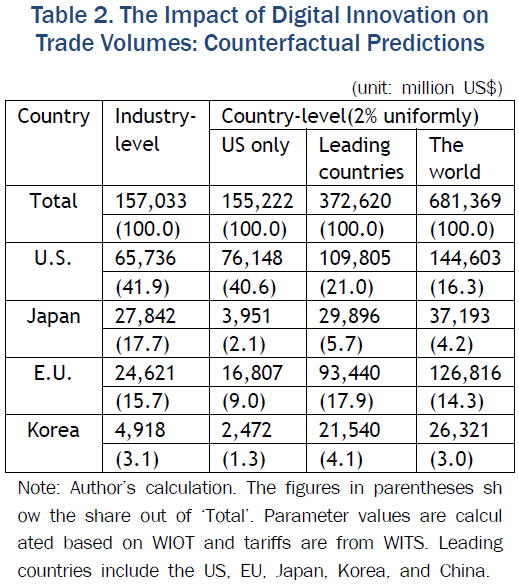 Counterfactual analysis based on a variant of the Ricardian model shows that digital innovation is beneficial to international trade. In other words, if digital innovation boosts fundamental productivity, it triggers growth in international trade at both sector-level and country-level. If countries/sectors have higher productivity due to digital innovation, those become much more competitive in producing goods or services, affecting trade share, price, expenditure, and many others within the model. As fundamental productivity induced by digital innovation becomes higher and the number of countries that experience enhanced productivity becomes larger, the model predicts that world trade volumes will grow larger accordingly. However, the growth in trade volumes is uneven. Although digital innovation contributes to the growth of world trade volumes, the increases in world trade are concentrated in certain countries and/or sectors that lead digital innovations.
V. Conclusions
This study provides the following implications for Korean private companies and its government. First, Korean private companies need to expand their R&D investments in software and programming related to Artificial Intelligence (AI), internet of things, and big data ‒ areas in which the quantitative as well as qualitative level of Korean patents are relatively low compared to the U.S. and Japan. They need to strengthen their competitiveness in digital innovation technologies. For its part, the government must step up wide-ranging deregulation measures to facilitate digital innovations related to data flow and technical interoperability.
Second, efficient policy governance needs to be set up to systematically support digital innovation in private sectors. This is because the digital policies in the age of the fourth industrial revolution are expected to have wide-ranging effects on the economy as well as society. According to an OECD study (2017) on national digital strategy governance, OECD member countries have allocated respective responsibilities to various ministries. A systematic governance system needs to be established to lead development, and to monitor and coordinate implementations.
Third, the Korean government needs to cooperate with WTO member countries to revise the international trade rules related to digital trade. In particular, trade rules such as the Technical Barriers to Trade (TBT), Intellectual Property Rights (IPR), and Telecommunication Agreements need to be urgently revised through WTO negotiations.
References
Caliendo, Lorenzo, and Fernando Parro. 2015. “Estimates of the Trade and Welfare Effects of NAFTA”, Review of Economic Studies, Vol. 82, No. 1, pp. 1-44.
Choi, Nakgyoon, Kyu Yub Lee, Hyuk-Hwang Kim, and Yoonjong Jang. 2018. International Comparison and Trade Effects of Digital In-novation According to Various Scenarios, Ko-rea Institute for International Economic Policy. Forthcoming.
Crafts, Nicholas. 2004. “Steam as a General Purpose Technology: A Growth Accounting Perspective”, Economic Journal, Vol. 114, No. 495, pp. 338-351.
Eaton, Jonathan, and Samuel Kortum. 2002. “Technology, Geography, and Trade”, Econ-ometrica, Vol. 70, No. 5, pp. 1741-1779.
Ethier, Wilfred J. 1982. “National and Interna-tional Returns to Scale in the Modern Theory of International Trade”, American Economic Review, Vol. 72, No. 3, pp. 389-405.
Graetz, Georg, and Guy Michales. 2015. “Ro-bots at Work: the Impact on Productivity and Jobs”, CEP Discussion Paper, No. 1335.
McKinsey Global Institute. 2017. A Future That Works Automation, Employment, And Productivity.
OECD. 2017. OECD Digital Economy Out-look 2017.
OECD. 2018. Going Digital in a Multilateral World. C/MIN(2018)6.
OECD.Stat. Information and Communication Technology. Available at https://stat.oecd.org (accessed December 20, 2018).
O'Mahony, Mary, and Marcel P. Timmer. 2009. “Output, Input and Productivity Measures at the Industry Level: The EU KLEMS Database”, Economic Journal, Vol. 119, No. 538, pp. 374-403.
USPTO. DVD-ROM.
Counterfactual analysis based on a variant of the Ricardian model shows that digital innovation is beneficial to international trade. In other words, if digital innovation boosts fundamental productivity, it triggers growth in international trade at both sector-level and country-level. If countries/sectors have higher productivity due to digital innovation, those become much more competitive in producing goods or services, affecting trade share, price, expenditure, and many others within the model. As fundamental productivity induced by digital innovation becomes higher and the number of countries that experience enhanced productivity becomes larger, the model predicts that world trade volumes will grow larger accordingly. However, the growth in trade volumes is uneven. Although digital innovation contributes to the growth of world trade volumes, the increases in world trade are concentrated in certain countries and/or sectors that lead digital innovations.
V. Conclusions
This study provides the following implications for Korean private companies and its government. First, Korean private companies need to expand their R&D investments in software and programming related to Artificial Intelligence (AI), internet of things, and big data ‒ areas in which the quantitative as well as qualitative level of Korean patents are relatively low compared to the U.S. and Japan. They need to strengthen their competitiveness in digital innovation technologies. For its part, the government must step up wide-ranging deregulation measures to facilitate digital innovations related to data flow and technical interoperability.
Second, efficient policy governance needs to be set up to systematically support digital innovation in private sectors. This is because the digital policies in the age of the fourth industrial revolution are expected to have wide-ranging effects on the economy as well as society. According to an OECD study (2017) on national digital strategy governance, OECD member countries have allocated respective responsibilities to various ministries. A systematic governance system needs to be established to lead development, and to monitor and coordinate implementations.
Third, the Korean government needs to cooperate with WTO member countries to revise the international trade rules related to digital trade. In particular, trade rules such as the Technical Barriers to Trade (TBT), Intellectual Property Rights (IPR), and Telecommunication Agreements need to be urgently revised through WTO negotiations.
References
Caliendo, Lorenzo, and Fernando Parro. 2015. “Estimates of the Trade and Welfare Effects of NAFTA”, Review of Economic Studies, Vol. 82, No. 1, pp. 1-44.
Choi, Nakgyoon, Kyu Yub Lee, Hyuk-Hwang Kim, and Yoonjong Jang. 2018. International Comparison and Trade Effects of Digital In-novation According to Various Scenarios, Ko-rea Institute for International Economic Policy. Forthcoming.
Crafts, Nicholas. 2004. “Steam as a General Purpose Technology: A Growth Accounting Perspective”, Economic Journal, Vol. 114, No. 495, pp. 338-351.
Eaton, Jonathan, and Samuel Kortum. 2002. “Technology, Geography, and Trade”, Econ-ometrica, Vol. 70, No. 5, pp. 1741-1779.
Ethier, Wilfred J. 1982. “National and Interna-tional Returns to Scale in the Modern Theory of International Trade”, American Economic Review, Vol. 72, No. 3, pp. 389-405.
Graetz, Georg, and Guy Michales. 2015. “Ro-bots at Work: the Impact on Productivity and Jobs”, CEP Discussion Paper, No. 1335.
McKinsey Global Institute. 2017. A Future That Works Automation, Employment, And Productivity.
OECD. 2017. OECD Digital Economy Out-look 2017.
OECD. 2018. Going Digital in a Multilateral World. C/MIN(2018)6.
OECD.Stat. Information and Communication Technology. Available at https://stat.oecd.org (accessed December 20, 2018).
O'Mahony, Mary, and Marcel P. Timmer. 2009. “Output, Input and Productivity Measures at the Industry Level: The EU KLEMS Database”, Economic Journal, Vol. 119, No. 538, pp. 374-403.
USPTO. DVD-ROM.
